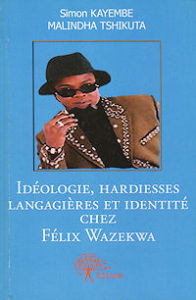tshikuta2013
|
Tshikuta, Simon Kayembe Malindha: |
 TABLE DES MATIÈRES
TABLE DES MATIÈRES
Remerciements 9
Préface 13
Avant-propos 19
Introduction générale 23
1. L’homme 37
2. L’œuvre de Félix Wazekwa 40
3. Du nom de l’orchestre 42
Premier chapitre
L’écriture comme idéologie musicale 45
1.0. Introduction 45
1.1. Notion d’écriture 45
1.2. Sillon épistémologique sur l’idéologie en litterature 46
1.2.1. Approches des relations entre idéologie et littérature 49
a. De Marx à Bourdieu 49
b. L’idéologie et le littéraire 56
c. L’idéologie en musique et en littérature 59
1.2.2. L’idéologie dans l’œuvre de Félix Wazekwa 60
Discours et paratopie 61
1.3. Organisation hiérarchisée 63
1.4. Syntaxe et énonciation 72
1.5. L’écriture de Félix Wazekwa entre la prose et la poésie 80
1.6. Les parallélismes sémantiques 82
1.6.1. Parallélismes d’opposition 83
1.6.2. Parallélismes de ressemblance 88
1.7. Le métadiscours et l’œuvre de Félix Wazekwa 91
1.7.1. Procédes métadiscursifs implicites 92
1.7.2. Procédes métadiscursifs explicites 95
Conclusion 99
Deuxième chapitre
Le verbe comme hardiesses langagières 101
2.0. Introduction 101
2.1. Les données du problème 101
2.2. Le « verbe » créé par l’artiste lui-même 103
2.3. Le « verbe » anonyme 105
2.4. La mise en forme du « verbe » 107
2.5. La valeur argumentative du « verbe » 110
2.5.1. Les lieux communs et l’argumentation 110
2.5.2. Les figements linguistiques 112
2.5.3. Les relations d’identification 114
2.5.4. L’éthos 116
2.5.5. Structure polyphonique 117
Conclusion 121
Troisième chapitre
Le style wazekween comme quête d’une identité 123
3.0. Introduction 123
3.1. Notion de style 123
3.2. Langage et identité 125
3.3. Ecarts par rapport au langage commun 126
3.3.1. Ecarts métaplasmiques 126
3.3.2. Ecarts lexicaux 127
3.3.3. Ecarts métataxiques 129
3.3.4. Ecarts métasémémiques 135
3.4. Localisations narratives 141
3.4.0. Position du problème 141
3.4.1. Deixis de la personne143
3.4.2. Deixis de l’espace 145
3.4.3. Deixis du temps 148
3.5. Autres indicateurs d’identité dans l’œuvre
de Félix Wazekwa 152
3.5.1. Sentiment de soi (la façon dont on se sent) 152
3.5.2. Image de soi (la façon dont on se voit, dont
on s’imagine) 153
3.5.3. Représentation de soi (la façon dont on peut se décrire) 154
3.5.4. Estime de soi (la façon dont on s’évalue) 155
3.5.5. Continuite de soi (la façon dont on se sent semblable ou
changeant) 156
3.5.6. Soi intime (celui que l’on est intérieurement) 157
3.5.7. Soi social (celui que l’on montre aux autres) 158
3.5.8. Soi idéal (celui que l’on voudrait être) 159
3.5.9. Soi vécu (celui que l’on se ressent être) 159
Conclusion 160
Quatrième chapitre
Ironie, diatribe, idéologie et intertextualité
dans l’œuvre de Félix Wazekwa 161
4.0. Introduction 161
4.1. Position du problème 161
4.2. Felix Wazekwa : du pamphlet à la diatribe 162
4.3. Ironie et idéologie 173
4.4. L’intertextualité et l’intratextualité chez Felix Wazekwa 176
4.4.1. L’intertextualité 176
4.4.2. Intratextualité 184
Conclusion 189
Conclusion générale 191
Postface 195
Annexe 199
Bibliographie 251
I. Dictionnaires 251
II. Ouvrages 252
III. Articles 260


 CONTENTS
CONTENTS CONTENTS
CONTENTS INHALT (Button Type)
INHALT (Button Type) CONTENTS
CONTENTS